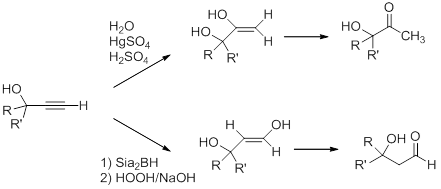16.06.3: Deprotonated Alkynes
- Page ID
- 23975
Conjugate base anions of terminal alkynes (acetylide anions) are nucleophiles, and can do both nucleophilic substitution and nucleophilic addition reactions.
Acidity of Terminal Alkynes: Formation of Acetylide Anions
Terminal alkynes are much more acidic than most other hydrocarbons. Removal of the proton leads to the formation of an acetylide anion. The origin of the enhanced acidity can be attributed to the stability of the acetylide anion, which has the unpaired electrons in an sp hybridized orbital. The stability results from occupying an orbital with a high degree of s-orbital character. There is a strong correlation between s-character in the orbital containing the non-bonding electrons in the anion and the acidity of hydrocarbons. The enhanced acidity with greater s-character occurs despite the fact that the homolytic C-H BDE is larger.
| Compound | Conjugate Base | Hybridization | "s Character" | pKa | C-H BDE (kJ/mol) |
| CH3CH3 | CH3CH2- | sp3 | 25% | 50 | 410 |
| CH2CH2 | CH2CH- | sp2 | 33% | 44 | 473 |
| HCCH | HCC- | sp | 50% | 25 | 523 |
Consequently, acetylide anions can be readily formed by deprotonation using a sufficiently strong base. Amide anion (NH2-), in the form of NaNH2 is commonly used for the formation of acetylide anions.


Nucleophilic Substitution Reactions of Acetylides
Acetylide anions are strong bases and strong nucleophiles. Therefore, they are able to displace halides and other leaving groups in substitution reactions. The product is a substituted alkyne.

Because the ion is a very strong base, the substitution reaction is most efficient with methyl or primary halides without substitution near the reaction center,


Secondary, tertiary or even bulky primary substrates will give elimination by the E2 mechanism.

Nucleophilic Addition of Acetylides to Carbonyls
Acetylide anions will add to aldehydes and ketones to form alkoxides, which, upon protonation, give propargyl alcohols.

With aldehydes and non-symmetric ketones, in the absence of chiral catalyst, the product will be a racemic mixture of the two enantiomers.
The triple bond in the propargyl alcohol can be modified by using the reactivity of the alkyne. For example, Markovnikov and anti-Markovnikov hydration of the triple bond leads to formation of the hydroxy-substituted ketone and aldehyde, respectively, after enol-keto tautomerization.

Problems
1. The pKa of ammonia is 35. Estimate the equilibrium constant for the deprotonation of pent-1-yne by amide, as shown above.
Answers
1. Assuming the pKa of pent-1-yne is about 25, then the difference in pKas is 10. Since pentyne is more acidic, the formation of the acetylide will be favored at equilibrium, so the equilibrium constant for the reaction is about 1010

